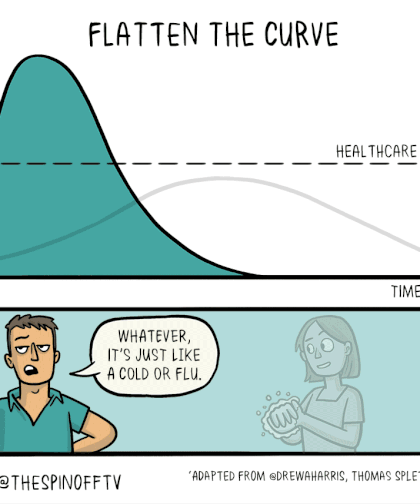So What Do We Already Know About the Virus:
- What are viral detectives?
In the same way that we have police officers and detectives that investigate crimes – viral detectives investigate viral outbreaks. We have systems like World Health Organization and the CDC to comprehensively investigate in situations like this. However, most of us at home, this is our first experience with a global pandemic like this; we're just not aware that there are trained health professionals and viral detectives who have dedicated their entire careers in tackling viral epidemics like this. This kind of pandemic may be new to most of us, but there has actually never been a time in human history where humans have not been in a tug of war battle with viruses.
- What is a virus?
A virus is essentially a micro parasite. Viruses use our body cells to replicate themselves. It uses our cells to make more of itself throughout our entire body. Once it uses a cell, it moves onto the next cell. However, in this process, when it uses a cell – the virus can fundamentally damage and destroy the cell that it's leaving. Therefore, that why's viruses like the coronavirus can be systematically destructive when a virus comes into contact with the humans.
- What does a global pandemic necessarily mean?
Often, when most of us hear the term, global pandemic, on the news, our minds instantly associate that with the movie, Contagion. However, a global pandemic is actually a worldwide outbreak of a new virus or bacteria that is going to affect people in every continent of the world.
- How exactly can you contract COVID-19?
Global health professionals are still gradually learning about how transmission of COVID-19 occurs. However, something we do know about this virus is that once this virus jumped from animals to human bodies – it was humans who transmitted this virus to other humans. There is a dynamic transmission when it comes to COVID-19, being that it has already rapidly spread to approximately 150 countries worldwide. Breathing air in and out amongst one another has become such a fundamental method of transmission that has enabled this virus to spread as increasingly and quickly as it has. If someone is a carrier of the virus, the virus will attach itself to very tiny particles that we normally breathe in and out which is essentially how the virus can spread from one another. Similarly, when one gets sick and begins coughing, the virus can disburse itself – amidst the dense particles – at a rate that is even higher. Therefore, when we breathe the same air space, this is how humans can transmit COVID-19 to one another.
- Why do masks and gloves do not necessarily work?
First of all, it is important for us to distinguish the various kinds of masks. One type of masks are surgical masks. When surgeons operate, they use masks in order to prevent the infected particles coming from one's mouth – when speaking with one another during surgery – to come into contact & further contaminate the incision. Though in some cases, surgical masks do work in blocking the bacterial agents that could contaminate oneself – in this case due to the very tiny particles that is particularly attached to this virus – a surgical mask would be generally insufficient since the particles could easily penetrate the open spaces near the mouth area of the mask. On the other hand, another kind of mask that is popular today is called the N95 respirator. This mask is tightly wrapped around the face in a matrix shape. It's essentially made out of a pored material that is sheer enough to let air through, but will not let the virus particles penetrate. This kind of mask should be exclusively designated for the health care professionals who currently on the line against COVID-19 still working long shifts at hospitals nationwide. Therefore, it is important to note how those who are wearing surgical mask as a means of protection in response to this pandemic – the mask does not do anything in substantially protecting oneself from the virus. Also, yes, hand-washing is generally very important to say the least. However, when it comes particularly to COVID-19, experts have enough information to conclude that transmission of this virus occurs very rarely from hand to hand contact or with one's environment (e.g touching a doorknob & touching your face) – rather - the most important way that this virus is transmitted is by breathing in the same air as one another. This particles attached to this virus can be diffused and spread into the air of an entire and one does not necessarily have to be within a six foot radius for this virus to spread. This kind of viral transmission with COVID is airborne – therefore – being COVID is incredibly difficult to contain amidst a space.
- Is it actually true that younger people are less prone to dying from COVID-19 opposed to older people?
Very few children are ultimately infected with COVID-19. Also, within those few case of children who are diagnosed with COVID-19, the vast majority of them are mild illnesses. It is true that those who are most vulnerable to COVID-19 are the individuals of older generations (those who are over age 55+) and those with preexisting respiratory conditions. For this reason, younger people should be the ones to make this difficult step and be an ally at this critical time by staying at home as opposed to going on that Spring break trip to Miami with your college friends or going to a crowded mall or bar – as a means to protect your grandparents and those whose health are already in severe jeopardy amidst this pandemic. Also, it is important to note that many individuals can be carriers of COVID-19 despite not showing symptoms. Therefore, there is a high chance that one could transmit COVID-19 to another without even knowing it.
- What you need to know about mortality rate when it comes to COVID-19:
- It is estimated that approximately 20-60% of the US population will contract COVID-19 within the next 6-12 months. However, it important to consider how those who are young and may contract COVID-19 – this it is obviously not good, but not outwardly terrible, as long as these individuals stay out of contact with those who are older and have underlying health conditions. I am going to very frank when saying this, but we are already way past any kind of hope for containment of this virus. Rather, what we can do at this point is evaluating the potential cases of contamination, working from there, and being prepared for the inevitable wave that COVID-19 will ultimately spur soon. Today, there is a largely declining supply of N-95 ventilators, hospital beds, and testing exams due to the shortcomings of the current US health care system.
- What are the symptoms of COVID-19 & how do you know when you need to be seen by a doctor?
On average, most carriers of COVID-19 often do not experience symptoms until their second or third week of infection which can detrimental to one's health. If you have flu like symptoms (e.g muscle ache, fever, chill, headache, dry cough), it is important to communicate with a medical clinic to discuss your following steps in ultimately getting diagnosed. It is important not immediately retreat to the emergency room – being that if you do have COVID-19 – you do not want to potentially infect someone else who is in the hospital.
- Why is "flattening the curve" so important?
Let's look at this scenario. Your local hospital can – under standard conditions – treat 40 patients daily, experiencing respiratory-related issues. However, if 50 individuals arrive at the hospital tomorrow, experiencing respiratory-related issues, there will be 10 surplus patients left in critical without access to sufficient medical resources in addressing the case. Therefore, it is ultimately pertinent that we all practice social distancing as a means to gradually flatten the curve, so we do not overwhelm the health care system. If we continue practice social distancing, this will enable our health system to get a better grip on how to control the spread of this virus. We've basically passed the point where our goal is to stop the virus; now, we're at the point where we're working towards how we're going to prevent this virus from causing our health care system from collapsing, as more and more hospitals nationwide are being overwhelmed with patients. The ultimate goal at this point in the United States is having a slow-pass through humanity which could potentially two to three months or even more. When someone contracts COVID-19 and is ultimately treated, they actually become a human to the disease subsequently. Therefore, when a huge proportion of the population are immune to COVID-19, that's what essentially prompts a bypassing of this virus. Also, considering we're currently in the process of crafting a vaccine, this will promote further assistance in addressing this pandemic properly. Health professionals do not have a strict deadline as when they think the vaccine can be distributed; however, it is estimated to be released in approximately 18 months at best. COVID-19 is not something to be absolutely terrified because we have to acknowledge the majority will inevitably have COVID-19 at some point in their lives. However, as humans gradually develop a sense of immunity against the virus & doctors are simultaneously crafting a vaccine to combat, these actions will hopefully enable humanity to bypass this disease overtime.
- What is the difference between epidemic, outbreak, and pandemic?
In the medical field, epidemic and outbreak are commonly used interchangeably. An epidemic is a disease that affects many people at the same time, and spreading from person to person in a local area – an outbreak. However, a pandemic is essentially a global epidemic, so that's why COVID-19 is notoriously noted as a pandemic across the media.
- Can COVID-19 mutate?
Despite viruses always commonly shifting, the Coronavirus, fortunately, COVID-19 will not fundamentally mutate from where it is at right now according to health professionals' speculation at the moment.



 Photo by
Photo by  Photo by
Photo by  Photo by
Photo by 



















